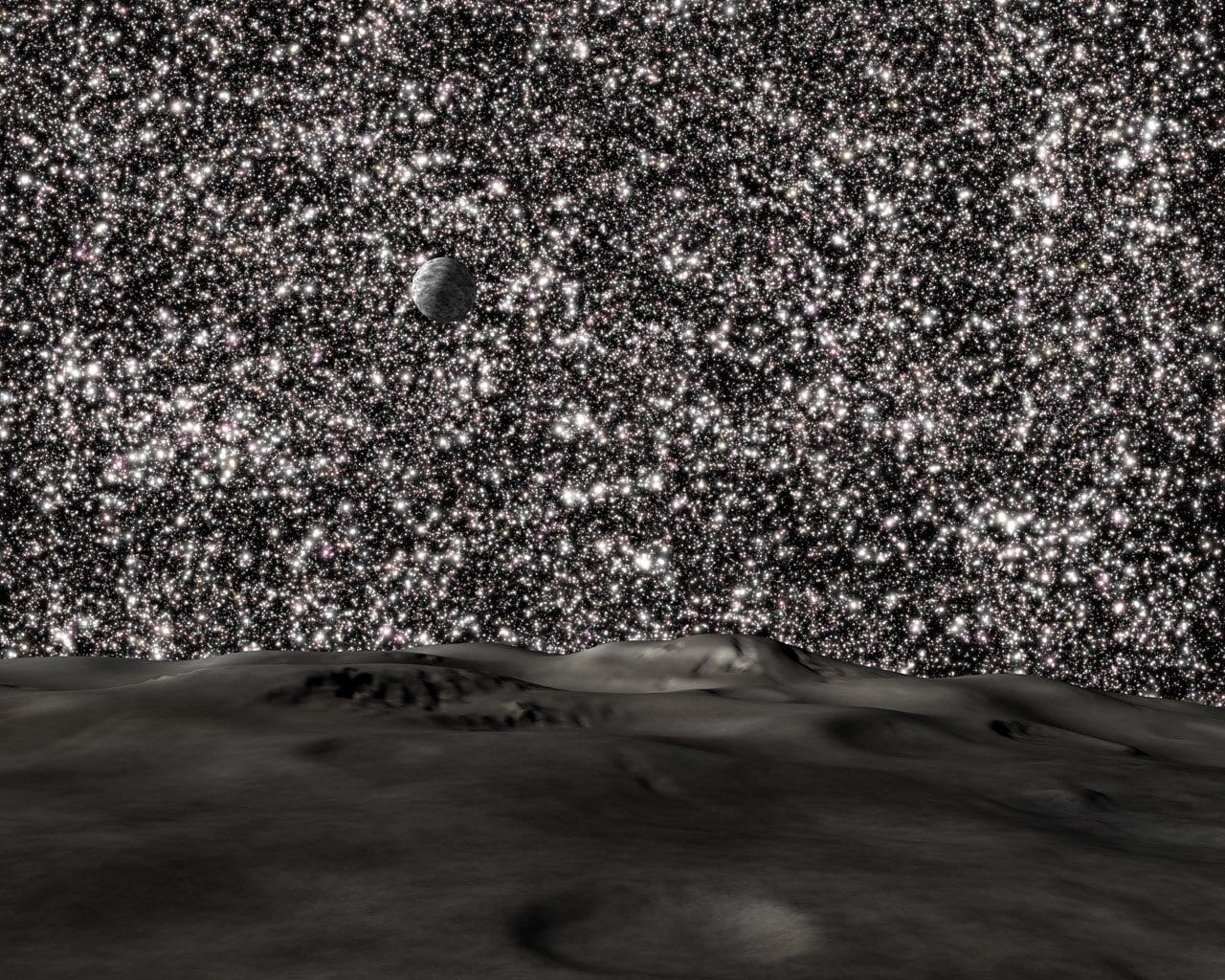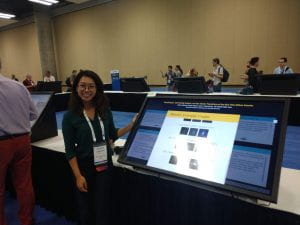Research: New Questions about Ancient Galaxy Formation

Artist’s depiction of the night sky as seen from a planet at the heart of an ultracompact galaxy. More than a million stars are visible with the naked eye, in contrast to the few thousand visible from Earth.
Scientists worldwide are rethinking theories about how galaxies form, thanks to new research by a San José State professor and his international team.
Department of Physics and Astronomy Professor Aaron Romanowsky and his coauthors announced in Science magazine that when they examined a globular cluster of stars orbiting the Andromeda galaxy, they found a surprising result. Astronomers expect stars in globular clusters to contain heavy elements like iron and magnesium. Yet the cluster Romanowsky and his team inspected, named EXT8, was so extremely “metal poor”—lacking elements heavier than hydrogen or helium—that their findings broke some galactic records.
At first, the team was merely puzzled that the cluster had so few metals, Romanowsky explains. “Gradually, we realized that’s not just curious,” he says. “That’s actually really important. It’s not only never been seen, but you don’t expect it ever to be seen. This could tell us something really important about star and galaxy formation.”
Our Milky Way’s Nearest Neighbor
Andromeda is a beautiful, classic, large spiral galaxy. It looks like a tilted platter of a trillion stars, spinning as if on a cosmic record player. Sometimes called the Milky Way’s “twin sister,” Andromeda is our own galaxy’s nearest neighbor.
“You can see Andromeda with the naked eye when you know exactly where to look,” Romanowsky says. “It’s relatively close by.” (It takes a mere 2.5 million years for its light to reach us!) “A lot of times, telescopes will be pointed very far at distant galaxies, and Andromeda is not studied as much these days.”
Both the Milky Way and Andromeda, beyond their edges, harbor hundreds of globular clusters, very dense clumps of millions of stars like the one named EXT8. It was a routine, known object, “sitting right under our noses,” Romanowsky says. “One that’s close by, that was overlooked.” The Milky Way’s globular clusters have been thoroughly examined, but not the roughly 460 clusters around Andromeda. “We happened to pick one that hasn’t been studied in detail yet.”
Every star has its own fingerprint. “One has more calcium, one has more magnesium,” he explains. “Dozens of different elements, and they’re all slightly different, star to star.” Romanowsky and his team averaged the metal content of stars found in EXT8 and discovered a profile previously thought impossible.
Astronomers have found other metal-poor globular clusters. But EXT8 turns out to be the most metal-poor globular cluster ever recorded. It averages 800 times less iron than our sun, is three times more iron-poor than any globular cluster previously measured, and is even more lacking in magnesium. Current theories predict such massive, ancient protogalaxies should never have been able to form with such characteristics. Romanowsky and his colleagues have upended that assumption.
What does EXT8 look like? From here, a telescope displays an isolated ball of stars. But what if we were there? Our solar system’s lonely neighborhood contains one star per cubic parsec of space; the most vivid, star-filled sky you can see from Earth contains only about 5,000 visible stars. Picture a million stars like our Sun in that same field of view. “The Sun’s nearest neighbor star is Alpha Centauri, about four light years away,” Romanowsky explains. “Imagine packing 50,000 stars within that distance instead of just one.” Not just in a straight line, but in every direction you look, within a sphere that size, filled with stars. “If you’re sitting on a planet in this globular cluster,” he says, “you look up at the sky and instead of a few thousand stars, you’d see a hundred thousand.” Barely any dark space between them maybe—the nighttime heavens unimaginably bright.
“If you go to Mount Hamilton for public viewing nights, they’ll point the telescope at globular clusters because they’re really spectacular,” Romanowsky says. “They’re these dense balls of stars. And they’ve become scientifically fascinating, because they’re some of the oldest parts of the universe, pre-dating most of our galaxy.”
A Look at the Night Sky is Time Travel
When we look up on a clear night, we are looking back in time, says Romanowsky. When we look through telescopes, we are looking way back in time.
“Powerful telescopes actually look into the past,” Romanowsky explains. Light takes a second to get from the Moon to the Earth, or eight minutes from the sun to the Earth. “So when you see the Sun, you’re actually seeing into the past eight minutes ago, effectively,” he says. “It’s not important—the sun doesn’t change in eight minutes. But the farther you go, the more that lag builds up. You can look all the way back to the infancy of the universe by looking far enough away: billions of years into the past.”
Romanowsky says globular clusters are particularly interesting “fossilized” astronomical objects. Globular clusters are “witnesses to the early universe, the first stages of star and galaxy formation,” he says. Some of the first objects to form, and orbiting far outside galaxies, globular clusters have been left undisturbed for billions of years. “The ones parked farther out have avoided getting destroyed by the galaxy’s gravity. Studying these globular star clusters is a really powerful way of finding out what happened at those early stages.”
In the early universe, as gas coalesced into more massive structures, the earliest galaxies had no metals. “You start off with gas and it collapses to form stars. When you have enough, it goes through a recycling process. Understanding how galactic recycling works is the cutting edge now, because the gas starts off with basically just hydrogen and helium. Then the stars start forming these heavier elements. They spew it back out into the gas around them, which forms new stars. In this process, the more recycling you get, the more contaminants you get in your stars.”
For a massive globular cluster of stars to form, its gravity should draw in gas with such heavy elements. Until now, astronomers thought all large globular clusters must contain a minimum amount of heavy elements. No one had found one like EXT8—and no one would have predicted it could exist.
“That’s what’s always fun,” he says. “When you find something new in what you thought you understood, you’ve poked a hole in your model. Something about your model is wrong now. Sometimes that wrong thing is just tweaking something, a minor revision where we need to go back and update the models a bit. But sometimes these holes you poke unveil something fundamentally wrong. A really big surprise.”
Our logical reasoning about star and galaxy formation now seems demonstrably flawed. “Something about how the recycling works or how the star clusters form, something’s wrong in there. We need to figure out what it is,” Romanowsky says.
Bonus Time Uncovers Treasure
Just over one year ago—October 25, 2019—Romanowsky’s team used their allotted time with Hawaii’s Keck 1 telescope and an instrument called HIRES to make observations of globular clusters. The team was using extra time on the telescope to examine “bonus objects,” Romanowsky says. “The result wasn’t something we were looking for when we found it. It began as a curiosity.”
As the Earth rotates, astronomers adjust. “You can’t see a single target during the course of the night. Usually it has a rising and setting time. Before it rises, you might fill that time with something slotted into extra time left over to do something that wasn’t planned.” The team happened to choose EXT8—and in their “spare time” discovered the most metal-poor globular cluster yet known to science.
Romanowsky is pleased that examining a near object—almost as an afterthought—led to paradigm-displacing results. “It shows how the universe still has many surprises for us to discover. It also reminds us to check our assumptions; in this case, it was assumed enough clusters had been investigated to know how anemic they can be.”
In October 2020, he and his coauthors Søren Larsen, Jean Brodie and Asher Wasserman published their report, titled “An Extremely Metal-deficient Globular Cluster in the Andromeda Galaxy,” in Science. Larsen, who formerly worked in California, is now at Radboud University in Nijmegen, the Netherlands. Brodie is an astronomer at UC Santa Cruz, and UC Santa Cruz graduate student Asher Wasserman manipulated the telescope.
Romanowsky has had scientific findings published in the premier journals Science and Nature before, but “it’s always fun to get a splashy result,” he says. For top researchers, it means having their work influence the widest realm possible. At a conference last May, Romanowsky enjoyed discussing his latest findings with his colleagues, experts in the field of globular clusters and galaxy formation. “Others are involved in the collaboration, but it’s a fairly small group on this particular paper,” he says. “Astronomy has always been good about international collaboration.” (The global community of astronomers isn’t too befuddled by working remotely; after all, the Internet was invented so physicists could share data and collaborate.)
Romanowsky’s work models the exploring his students are learning to do. “Our students behind the scenes are always trying to find more interesting objects. I appreciate San José State’s support in pursuing this,” Romanowsky says. “An important part of the university’s mission is just to generate knowledge.”




